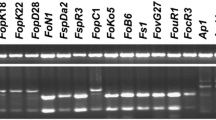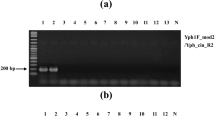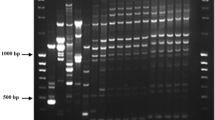Abstract
A pair of PCR primers, QH-OLS05/QH-OLS08 specific for strains of Xylella fastidiosa causing oleander leaf scorch was developed. The primers were designed according to a DNA sequence of a randomly amplified polymorphic DNA (RAPD)-polymerase chain reaction (PCR) product unique to oleander strains. The PCR assay using primer pair QH-OLS05/QH-OLS08 allowed quick and simple detection and identification of oleander strains in cultured bacterium and infected plant samples. The assay also can be applied to insect samples. Specific detection and identification of oleander strains of X. fastidiosa by PCR is useful for epidemiologic and etiologic studies of oleander leaf scorch by identifying what plants and insect vectors harbor or carry this particular strain of X. fastidiosa, especially in locations where mixed natural infections by oleander and other strains of X. fastidiosa occur.




Similar content being viewed by others
References
Altschul SF, Madden TL, Schaffer et al (1997) Gapped BLAST and PSI-BLAST: a new generation of protein database search programs. Nucleic Acids Res 25:3389–3402
Chen J, Banks D, Jarret RL et al (2000) Use of 16S rDNA sequences as signature characters to identify Xylella fastidiosa. Curr Microbiol 40:29–33
Costa HS, Raetz E, Pinckard TR et al (2004) Plant hosts of Xylella fastidiosa in and near southern California vineyards. Plant Dis 88:1255–1261
da Costa PI, Franco CF, Miranda VS et al (2000) Strains of Xylella fastidiosa rapidly distinguished by arbitrarily primed-PCR. Curr Microbiol 40:279–282
Davis MJ, Raju BC, Brlansky RH et al (1983) Periwinkle wilt bacterium: axenic culture, pathogenicity, and relationships to other Gram-negative, xylem-inhabiting bacteria. Phytopathol 73:1510–1515
Hendson M, Purcell AH, Chen D et al (2001) Genetic diversity of Pierce’s disease strains and other pathotypes of Xylella fastidiosa. Appl Environ Microbiol 67:895–903
Hernandez-Martinez R, Costa HS, Dumenyo CK, Cooksey DA (2006) Differentiation of strains of Xylella fastidiosa infecting grape, almonds, and oleander using a multiprimer PCR assay. Plant Dis 90:1382–1388
Hopkins DL (1989) Xylella fastidiosa: Xylem-limited bacterial pathogen of plants. Annu Rev Phytopathol 27:271–290
Hopkins DL, Purcell AH (2002) Xylella fastidiosa: cause of Pierce’s disease of grapevine and other emergent diseases. Plant Dis 86:1056–1066
Huang Q (2007) Natural occurrence of Xylella fastidiosa in a commercial nursery in Maryland. Can J Plant Pathol 29:299–303
Huang Q, Sherald JL (2004) Isolation and phylogenetic analysis of Xylella fastidiosa from its invasive alternative host, porcelain berry. Curr Microbiol 48:73–76
Huang Q, Li W, Hartung JS (2003) Association of Xylella fastidiosa with leaf scorch in Japanese beech bonsai. Can J Plant Pathol 25:401–405
Huang Q, Brlansky RH, Barnes L et al (2004) First report of oleander leaf scorch caused by Xylella fastidiosa in Texas. Plant Dis 88:1049
Huang Q, Bentz J, Sherald JL (2006) Fast, easy, and efficient DNA extraction and one-step PCR for the detection of Xylella fastidiosa in potential insect vectors. J Plant Pathol 88:77–81
Kamper SM, French WJ, DeKloet SR (1985) Genetic relationships of some fastidious xylem-limited bacteria. Int J Syst Bacteriol 35:185–188
McElrone AJ, Sherald JL, Pooler MR (1999) Identification of alternative hosts of Xylella fastidiosa in the Washington, DC area using nested polymerase chain reaction (PCR). J Arboricul 25:258–263
Mehta A, Rosato YB (2001) Phylogenetic relationships of Xylella fastidiosa strains from different hosts based on 16S rDNA and 16S–23S intergenic spacer sequences. Int J Syst 51:311–318
Minsavage GV, Thompson CM, Hopkins DL et al (1994) Development of a polymerase chain reaction protocol for detection of Xylella fastidiosa in plant tissue. Phytopathol 84:456–461
Pooler MR, Hartung JS (1995) Genetic relationships among strains of Xylella fastidiosa from RAPD-PCR data. Curr Microbiol 31:134–137
Pooler MR, Hartung JS (1995) Specific PCR detection and identification of Xylella fastidiosa strains causing citrus variegated chlorosis. Curr Microbiol 31:377–381
Purcell AH, Saunders SR (1999) Fate of Pierce’s disease strains of Xylella fastidiosa in common riparian plants in California. Plant Dis 83:825–830
Purcell AH, Saunders SR, Hendson M et al (1999) Causal role of Xylella fastidiosa in oleander leaf scorch disease. Phytopathol 89:53–58
Schaad NW, Postnikova E, Lacy G et al (2004) Xylella fastidiosa subspecies X. fastidiosa subsp. piercei, subsp. nov., X. fastidiosa subsp: multiplex subsp. Nov., and X. fastidiosa subsp. pauca subsp. nov. System Appl Microbiol 27:290–300
Schuenzel EL, Scally M, Stouthamer R, Nunney L (2005) A multigene phylogenetic study of clonal diversity and divergence in North American strains of the plant pathogen Xylella fastidiosa. Appl Environ Microbiol 71:3832–3839
Sherald JL (2001) Xylella fastidiosa: a bacterial pathogen of landscape trees. In: Ash CL (ed) Shade tree wilt diseases. Proceedings of wilt diseases of shade trees: a national conference, 25–28 August 1999. APS Press, St. Paul, MN, pp 191–202
Sherald JL, Wells JM, Hurtt SS, Kostka SJ (1987) Association of fastidious, xylem-inhabiting bacteria with leaf scorch in red maple. Plant Dis 71:930–933
Wells JM, Raju BC, Hung H et al (1987) Xylella fastidiosa gen. nov., sp. nov.: Gram-negative, xylem-limited, fastidious plant bacteria related to Xanthomonas spp. Int J Syst Bacteriol 37:136–143
Williams JGK, Kubilik AR, Livak KJ et al (1991) DNA polymorphisms amplified by arbitrary primers are useful as genetic markers. Nucleic Acids Res 18:6531–6535
Author information
Authors and Affiliations
Corresponding author
Rights and permissions
About this article
Cite this article
Huang, Q. Specific Detection and Identification of Xylella fastidiosa Strains Causing Oleander Leaf Scorch Using Polymerase Chain Reaction. Curr Microbiol 58, 393–398 (2009). https://doi.org/10.1007/s00284-008-9324-4
Received:
Revised:
Accepted:
Published:
Issue Date:
DOI: https://doi.org/10.1007/s00284-008-9324-4




